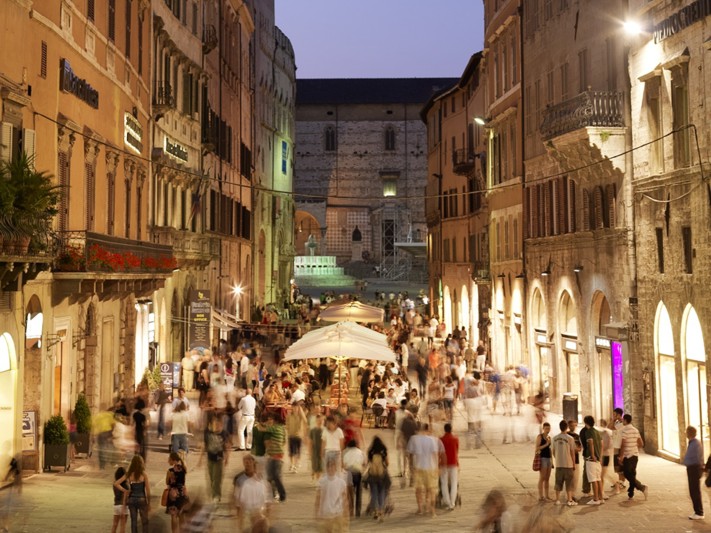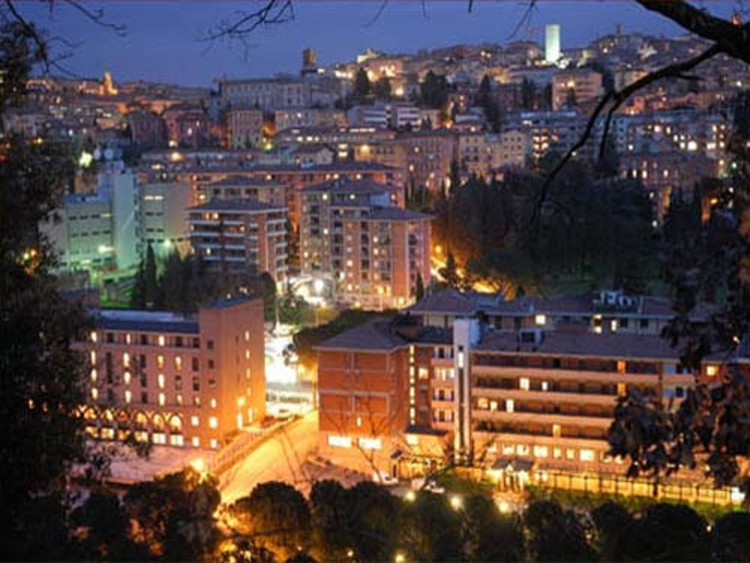
The Three Communities Of Perugia And Why American Students Tend To Run Wild
Perugia’s population these days is just short of 200,000 and of those about 20,000 are either visiting foreigners or foreign-born long-term residents.
Perugia’s population is growing at twice the Italian national average, and higher education and research is by far its largest industry. The University of Perugia is very old and it is the largest of a number of universities, colleges and institutes.
The numbers of people in town on any given day, week or month fluctuate far more than in most Italian cities. During the public holidays and university vacations, the old city can be extremely quiet - most of our Perugia shots here were taken in the quiet phases when almost nobody was around.
But when the colleges are all in session, and when there is a football match (Perugia has a very popular team), and when there is one of the frequent annual festivals (chocolate, jazz, and so on) Perugia can be very hard to drive, park, or even walk in the main piazzas.
The three communities referred to here are (1) the long-term residents who, although far from outnumbered, seem to feel increasingly hard-pressed; (2) the large body of serious students, who work hard at their education to the excellent standards the Perugia institutions maintain, and (3) a smaller but less restrained element which tends to get into drugs and party loudly, and on football and festival days make the town seem to some threatening and out of control.
Incidents in Italy involving American students surface periodically in the news. The most notorious cases in the past couple of years were not in Perugia but in Florence, a couple of hours drive directly north. We don’t believe there is any blanket anti-Americanism in Italy but cases like this and also this do tend to get people ticked.
We posted nearly a year ago on a police clamp-down on the sale of drugs in Perugia. This drive seemed to have much accelerated after Meredith’s murder. A clear majority of those involved with illegal drugs - both in the selling and the using of the drugs - are said to be non-Italian.
This is an excerpt from Barbie Nadeau’s new book which shares her insights on this sometimes turbulent town.
It is 2 a.m. on a sticky September night, and Perugia is a cauldron of illicit activity. A thick fog of marijuana hangs over the Piazza IV Novembre. Empty bottles and plastic cups litter the cobbled square. The periphery is lined with North African drug dealers, selling their wares like the fruit vendors who occupy this spot in daytime hours. A group of pretty young British students giggle, easy prey to the Italian guys pouring their drinks. The American girls are more aggressive, eager to nab an Italian lover. Down an alley, a young man has lifted the skirt of his conquest and is having clumsy sex with her under a streetlamp while her drink spills out of the plastic cup in her hand. Dozens of students are passed out on the steps of the church. There is not a cop in sight.
This is the scene that greets the study-abroad crowd when they enroll at Perugia’s universities for foreigners. It comes as a shock to some and an irresistible circus to others, and it was the backdrop for tragedy in the case of two young women, Amanda Marie Knox, then 20, and Meredith Susana Cara Kercher, 22, who arrived in the fall of 2007 and enthusiastically joined the party. Less than two months later, Meredith was dead, and Amanda was in prison, accused of her murder.
These young women were not exactly innocents abroad. They had both done their share of college partying before they arrived in Italy. But that was hardly preparation for the nonstop bacchanalia that has made Perugia infamous on the international student circuit. Tina Rocchio is the Italy coordinator of Pennsylvania’s Arcadia University, which facilitates many study-abroad trips. “When they want to go to Perugia, my first question is always, “˜How much self-discipline do they have?’ before I can recommend it,” she says. “Perugia is not for the weak. The students who go there are of two veins””either they party or they study, and Perugia usually means a party.”
In the 1920s, Benito Mussolini established universities for foreigners in Perugia and nearby Siena, aiming to spread Italy’s “superior culture” around the world by recruiting foreigners to study cheaply in these lovely, walled cities. The Siena school remains relatively small. But the school in Perugia, in tandem with the city’s Università degli Studi, which also caters to foreigners but has a larger contingent of Italians, spawned dozens of smaller satellite campuses. There are so many that the town’s student population is now roughly 40,000, around a quarter of the city’s total population of 163,000. Perugia is popular among foreign students looking for something cheaper and cozier than Paris, Barcelona, or Florence, these last three cities being the top choices for well-heeled Americans. The academic offerings are wide-ranging, and the professors have a reputation for being forgiving. Sometimes, the college credits transfer back home as a simple pass-fail mark, when they should actually be given a grade-point score. All this attracts an eclectic mix of young people from around the globe. Most of the Italian kids come from wealthy families; in Italy, university students usually live at home, and it is a rare privilege to go away to school. The foreign students””the universities are accredited in Asia, Europe, and North America””are more likely to be scraping by on scholarships and second jobs. With very few dorm rooms available, the students usually live in the historic center in flophouses and apartments that have been partitioned into tiny rooms to accommodate multiple renters. The town is full of discos, clubs, and cheap restaurants that cater to a student clientele.
No surprise, Perugia is also a drug dealer’s paradise; the mostly North African merchants do a lively trade in everything from genetically modified hashish to cocaine and acid. It is very easy to get high in Perugia, and the police generally turn a blind eye. Perugia has a very low crime rate compared with the rest of Italy. Despite its reputation, drug arrests are rare, and the police are routinely lenient with the student population. The narrow, cobbled streets, some of which are built in steps, discourage car use, so the students stagger around the city center on foot, and the drunk driving offenses that usually dominate college-town crime dockets are not a problem. Murders are extremely rare””with one notable exception. The year before Meredith was killed, another young woman, Sonia Marra, who was studying medicine at the Università degli Studi, disappeared without a trace. The body has never been found, and it was only recently that her former boyfriend was arrested in connection with her murder””amid suspicions that the investigation into her death was neglected during the two-year circus following Meredith’s murder.
Perugia was home to the famous artist Pietro Vannucci, who went on to teach Renaissance great Raphael. It is also famous for the Perugina chocolate factory, now owned by Nestlé. But without the universities, Perugia would be just another postcard-perfect Umbrian hill town competing for the tourist dollar with Siena, Assisi, and St. Gimagnano. The local community looks askance at the wild student culture, but also knows better than to interfere much with the town’s economic mainstay. As one Perugian prosecutor told a reporter, with long-suffering tolerance, “This kind of intoxicating freedom gets into these kids so far away from home, this total lack of control, this hunger for experience rules these kids.” The universities and administrators of study-abroad programs contribute immensely to Perugia, and they expect the local community to be forgiving. They insist, too, that the party scene it is no worse here than any other college town.
Perhaps if someone had done their due diligence on the Perugia scene, Amanda Knox would not be where she is now.
And of course Meredith would still be alive.
Tweet This Post
TweetComments
No comments yet. Commenting is not available in this channel entry.Where next:
Click here to return to The Top Of The Front PageOr to next entry Part Of Meredith’s Emerging Legacy? A Kind, Caring, Safe, Well-Run Perugia
Or to previous entry Italian Tourism Bouncing Back: Perugia Becoming More Visited


